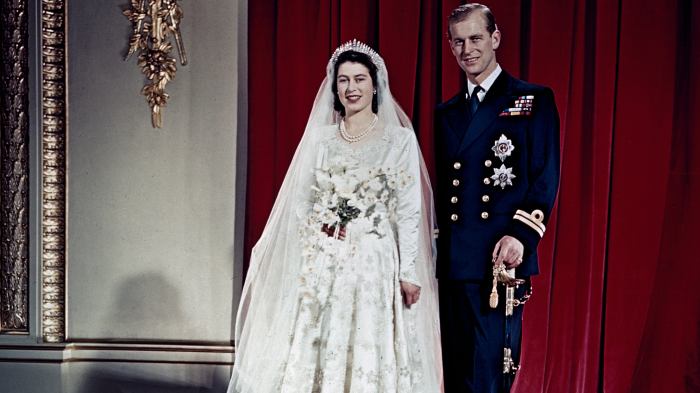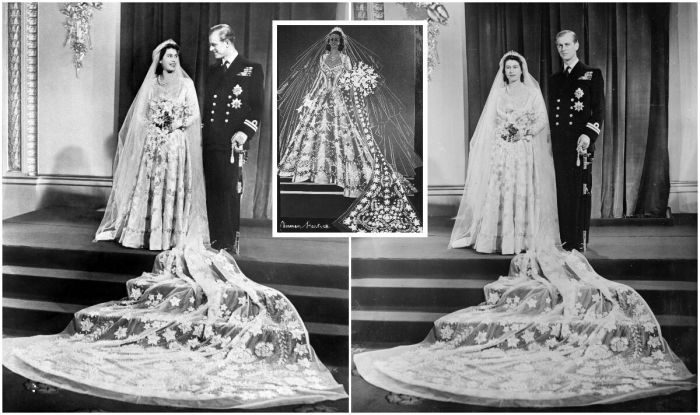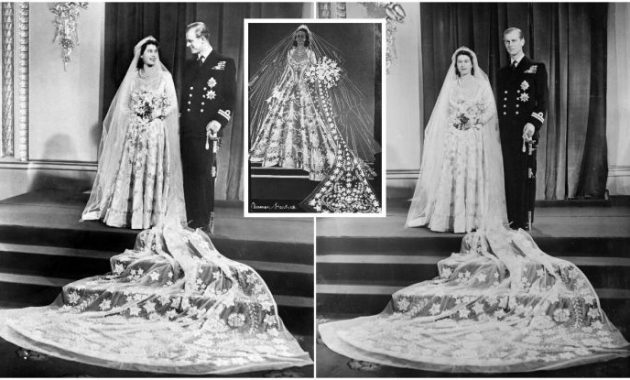Queen Elizabeth II’s Wedding Dress: A Timeless Icon: Dress Queen Elizabeth Wedding
Dress queen elizabeth wedding – Queen Elizabeth II’s wedding dress, a symbol of post-war hope and enduring elegance, continues to captivate audiences worldwide. Its design, materials, and the circumstances surrounding its creation all contribute to its iconic status. This article delves into the various aspects of this historical garment, exploring its design, social context, creation, legacy, and lasting visual impact.
The Dress Design and Materials
Designed by Norman Hartnell, the dress was a masterpiece of understated elegance. The ivory silk satin gown featured a full, flowing skirt, a fitted bodice, and a long train. The high neckline and long sleeves were characteristic of the era’s modest fashion trends, while the intricate detailing added a touch of royal opulence. The dress was adorned with thousands of seed pearls and crystals, meticulously hand-sewn, creating a shimmering effect.
The fabric itself was chosen for its luxurious feel and timeless appeal. The use of ivory, rather than traditional white, was a subtle nod to the prevailing mood of post-war austerity. The choice of silk satin, while luxurious, also reflected the need to use materials that were readily available during rationing.
The Significance of the Norman Hartnell Design
Norman Hartnell, a renowned British designer, was a trusted choice for the royal family. His design for the Queen’s wedding dress perfectly captured the spirit of the time: a blend of elegance and simplicity that reflected both the royal status and the nation’s post-war mood. Hartnell’s understanding of royal protocol and his ability to create a timeless design solidified the dress’s place in history.
Comparison to Other Royal Wedding Gowns
Queen Elizabeth II’s wedding dress stands apart from other royal wedding gowns, not only in its historical context but also in its design elements. While many royal brides have opted for elaborate embellishments and dramatic silhouettes, Elizabeth’s dress was characterized by its refined simplicity. This table provides a comparison to other notable royal wedding dresses:
| Bride | Fabric | Embellishments | Silhouette |
|---|---|---|---|
| Queen Elizabeth II | Ivory silk satin | Seed pearls, crystals | Fitted bodice, full skirt |
| Princess Diana | Silk taffeta, antique lace | Lace, puff sleeves | Puff sleeves, voluminous skirt |
| Kate Middleton | Satin, lace | Lace appliqués | Fitted bodice, A-line skirt |
| Meghan Markle | Silk crepe | Minimalist design | Simple A-line |
The Social and Historical Context of the Wedding

Source: aetnd.com
World War II significantly impacted the wedding and the design of the dress. The war’s austerity measures meant that rationing was still in effect, limiting the availability of luxurious materials. Hartnell had to work within these constraints, cleverly incorporating readily available materials to create a dress that was both elegant and appropriate for the times. The public’s reaction to the wedding was overwhelmingly positive; it was seen as a symbol of hope and a return to normalcy after years of hardship.
The dress itself became a symbol of national pride and resilience.
Timeline of Events Leading to the Wedding
The planning and creation of the dress were interwoven with the broader events leading up to the royal wedding. The following timeline highlights key moments:
- Early 1947: Engagement of Princess Elizabeth and Lieutenant Philip Mountbatten announced.
- Spring 1947: Design and creation of the wedding dress begins, amidst post-war rationing.
- November 20, 1947: The wedding of Princess Elizabeth and Philip Mountbatten takes place at Westminster Abbey. The dress is unveiled, capturing the nation’s attention.
The Makers and Craftsmanship of the Dress
The creation of Queen Elizabeth II’s wedding dress was a collaborative effort involving several skilled individuals. Norman Hartnell led the design, but a team of seamstresses worked tirelessly to bring his vision to life. The meticulous hand-sewing of the thousands of pearls and crystals exemplifies the exceptional craftsmanship of the era. The challenges included sourcing materials under rationing and meeting tight deadlines.
The dress’s construction showcases the high standards of tailoring and embellishment prevalent during that time.
Queen Elizabeth’s wedding dress, a Norman Hartnell design, set a standard for royal bridal elegance. The question of appropriate attire for guests often arises, prompting consideration of the dress code; for instance, one might wonder, as detailed in this helpful guide can you wear short dress to formal wedding ? Understanding this helps contextualize the formality expected at such events, contrasting sharply with the iconic length of Queen Elizabeth’s own gown.
Step-by-Step Guide to Replicating Key Design Elements

Source: co.uk
Creating a replica of Queen Elizabeth II’s wedding dress would require significant skill and attention to detail. Here’s a simplified Artikel focusing on key elements:
- Pattern Drafting: Create a pattern based on the dress’s silhouette, considering the fitted bodice and full skirt.
- Fabric Selection: Choose a high-quality ivory silk satin or a suitable alternative.
- Embellishment Application: Meticulously sew thousands of seed pearls and crystals onto the fabric, following the original design’s pattern.
- Construction: Assemble the bodice, skirt, and train, paying close attention to seams and finishing.
The Legacy and Influence of the Dress
Queen Elizabeth II’s wedding dress continues to inspire royal and non-royal brides alike. Its simple elegance and timeless design remain relevant decades later. The dress’s influence can be seen in various modern wedding dress trends, particularly the emphasis on classic silhouettes and refined details. The dress has been referenced in numerous films, television shows, and other media, cementing its place in popular culture.
- Kate Middleton’s wedding dress (2011)
- Several modern bridal gowns featuring long sleeves and high necklines.
Visual Representation of the Dress, Dress queen elizabeth wedding
The dress presented a stunning visual impact. The ivory silk satin had a subtle sheen, creating a soft, luxurious look. The thousands of seed pearls and crystals shimmered subtly under the light, adding a touch of sparkle without overpowering the dress’s elegant simplicity. The full skirt flowed gracefully, complementing the bride’s figure. The long train added a touch of regal drama, trailing behind her as she walked down the aisle.
To someone unfamiliar with the dress, one could describe it as a vision of understated elegance – a flowing ivory gown, shimmering with delicate pearls and crystals, a perfect embodiment of royal grace and post-war hope.
FAQs
What type of fabric was used in Queen Elizabeth’s wedding dress?
The dress was primarily made of ivory silk crepe, a heavy, durable fabric suitable for the occasion.
How many people worked on creating the dress?
While the exact number is uncertain, a team of skilled seamstresses and designers at Norman Hartnell’s atelier contributed to its creation.
Where is the dress now?
It is not publicly displayed but remains in the Royal Collection.
Did the dress include any embellishments?
Yes, it featured delicate floral embroidery and thousands of seed pearls.
How long was the train on the dress?
The train was quite long, adding to the dress’s dramatic effect.

